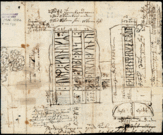- Gorm, Thyra and Harald
- The rune stones
- Gorm the Old’s rune stone
- Harald Bluetooth’s rune stone
- Basse’s rune stone
- How are rune stones read?
- The rune stones past and present
- Henrik Rantzau’s view, 1591
- Jon Skonvig, 1627
- Søren Abildgaard, 1771
- Ole Jørgen Rawert, 1819
- Adam Müller, 1835
- Jakob Kornerup, 1861
- Julius Magnus-Petersen, 1869-71
- Julius Magnus-Petersen, 1878
- Hans Andersen Kjær, 1897
- Photographs by a member of the public, 1935
- Runologist Erik Moltke, 1971
- Ludvig Stubbe-Teglbjærg’s rubbings, 1973
- Peter Henrichsen, moulding and copying in 1984
- Roberto Fortuna, 2006
- The conservation investigation 2006-08
- 3D light scanning, 2007
- Harald Bluetooth’s rune stone at home and abroad
- Pictures from Jelling
Søren Abildgaard, 1771
For many years the archive illustrator Søren Abildgaard (1718-1791) travelled around Denmark every summer to draw monuments. He received a small yearly payment from the king for this of 300 rix-dollars. The aim was presumably a large publication with illustrations in the form of engravings. The project did not progress so far as this. Nevertheless more than 800 drawings and engravings have survived until today. One of these summer journeys brought Abildgaard to Jelling in July 1771, to draw both the monuments and the two rune stones.
Abildgaard’s drawings consist of sketches, together with numerous notes, measurements and other details. In addition, to the front and back sides of Gorm’s small rune stone, the base was also drawn, whilst Harald’s large rune stone was drawn from two angles, the text side alone and the animal and Christ sides together. In the notes on the small rune stone is written that there “...are in the second and third lines some runes broken off” and Abildgaard noted about the inscription at the top of the back side that “...it is thought uncertainly that the last word in this line has two or three runes ....” He wrote about the Christ side of the large rune stone that there are “...some runes broken off in a gap of 14 ¾ inches length”.
The rune stones as information source
From a conservation perspective it is clear that Abildgaard’s aim was primarily to communicate information about the inscriptions and not the stones. He used rulers so that the inscriptions could be shown clearly, whilst the outline and proportion of the stones was reproduced in a relatively stylised way. The drawing of Gorm’s rune stone shows the suggestion of a broken-off area on the front side of the stone. Abildgaard has hatched an area and a rune is left out in both of the words karþi and aft, in respectively the first and second lines. He has also drawn just one spiral as an upper termination of the rune band on the right of the back side. Even at that time the motif must have been hard to make out because of decomposition.
The drawing of the large rune stone lacks precise details, but Abildgaard indicates that the large triangular piece at the top, as well as around half of the decoration over the inscription on the text side, are missing. On the text side there is some hatching between the runes f and t in aukaft in the third line’s first word and between r and i in haraltr ias at the beginning of the fourth line. In the accompanying text Abildgaard expresses the great difficulties of reading in the areas where the most damage can be seen today, especially on the text side’s bottom line. There is also hatching on the animal side between the runes a and l in ala, which Abildgaard refers to as an irregularity in the text. In the sketch of the Christ side he has marked a gap between the words tãni and kristnã.



